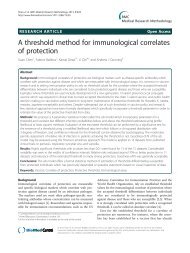Australian Cerebral Palsy Child Study: protocol of ... - BioMed Central
Australian Cerebral Palsy Child Study: protocol of ... - BioMed Central
Australian Cerebral Palsy Child Study: protocol of ... - BioMed Central
You also want an ePaper? Increase the reach of your titles
YUMPU automatically turns print PDFs into web optimized ePapers that Google loves.
Boyd et al. BMC Neurology 2013, 13:57 Page 8 <strong>of</strong> 12<br />
http://www.biomedcentral.com/1471-2377/13/57<br />
lobes involved, (ii) number <strong>of</strong> slices on the template that<br />
were affected and (iii) size and distribution <strong>of</strong> the lesion<br />
measured by a global lesion score and lesion subscores.<br />
The number <strong>of</strong> lobes and slices affected will be the average<br />
<strong>of</strong> summed right and left hemispheres. To calculate<br />
total lesion score, each frontal, parietal, temporal and occipital<br />
lobe will be first considered in three sections: periventricular,<br />
middle and subcortical matter. Each section<br />
will be scored as 0.5 if less than 50% <strong>of</strong> area was involved;<br />
or 1, for greater than 50% involvement, with a maximum<br />
lobar score <strong>of</strong> 3. Lobar scores for each hemisphere will be<br />
summed, with a maximum hemispherical score <strong>of</strong> 12 possible.<br />
The total lesion score will be the sum <strong>of</strong> right and<br />
left hemispherical scores (maximum score 24). A 1-point<br />
score (involved/not involved) will also be attributed to 16<br />
anatomical structures including the corpus callosum, the<br />
cerebellum and the main subcortical structures. The final<br />
maximum score <strong>of</strong> the scale will therefore be 40 (24 + 16).<br />
Gross motor function<br />
At each assessment gross motor function is evaluated<br />
using the GMFM-66 & GMFM-88 [46]. The GMFM-88<br />
assesses childrens’ motor abilities in lying to rolling, sitting,<br />
crawling to kneeling, standing, walking, running<br />
and jumping. The GMFM-66 is comprised <strong>of</strong> a subset <strong>of</strong><br />
the 88 items identified (through Rasch analysis) as contributing<br />
to the measure <strong>of</strong> gross motor function in children<br />
with cerebral palsy. The GMFM-66 will be used to<br />
provide an overall measure <strong>of</strong> gross motor function and<br />
the GMFM-88 domain scores to explore specific motor<br />
skills [46]. Measures <strong>of</strong> GMFM will be rated by experienced<br />
research physiotherapists.<br />
Secondary measures<br />
Gross motor function classification system (GMFCS)<br />
The Gross Motor Function Classification System (GMFCS)<br />
is a five level classification system <strong>of</strong> children’s functional<br />
gross motor severity. It is based on self-initiated movements,<br />
anti-gravity postures and motor skills expected in a<br />
typical five year old [25,26]. <strong>Child</strong>ren who are independently<br />
ambulant are classified as GMFCS I or II, those<br />
requiring an assistive mobility device to walk classified as<br />
GMFCS III and those in wheeled mobility as GMFCS IV<br />
and V. Two physiotherapists, trained in the use <strong>of</strong> the<br />
GMFCS, independently observe and classify children in<br />
one <strong>of</strong> five functional categories [25]. The GMFCS has<br />
internationally established validity, reliability and stability<br />
for the classification and prediction <strong>of</strong> motor function <strong>of</strong><br />
children with CP aged 2–12 years [24,25]. It has a high<br />
inter-rater reliability (generalisability coefficient = 0.93)<br />
[25]. Classifications <strong>of</strong> gross motor abilities change with<br />
age, therefore separate descriptions are used for different<br />
age bands. In the current study, the
















